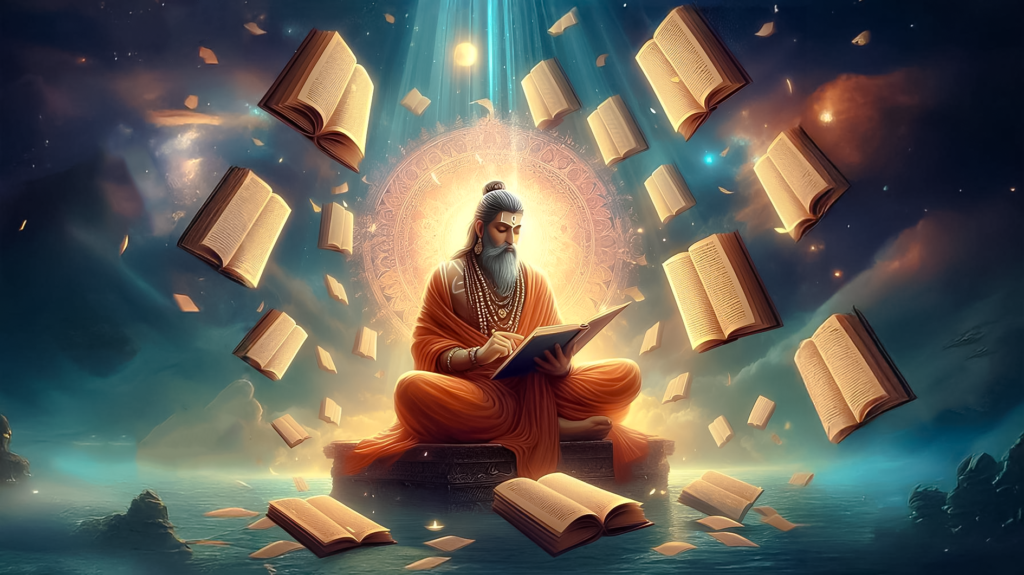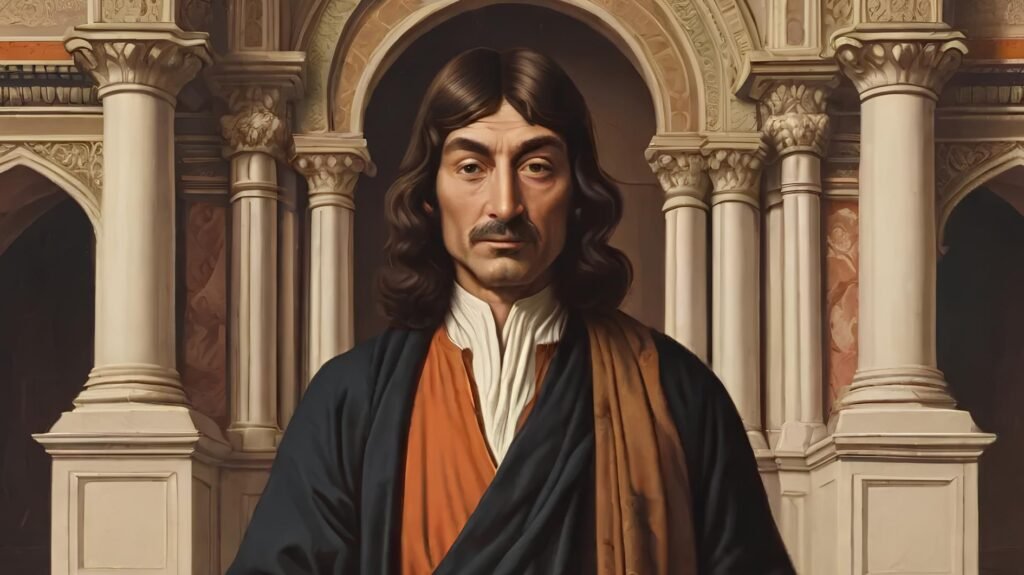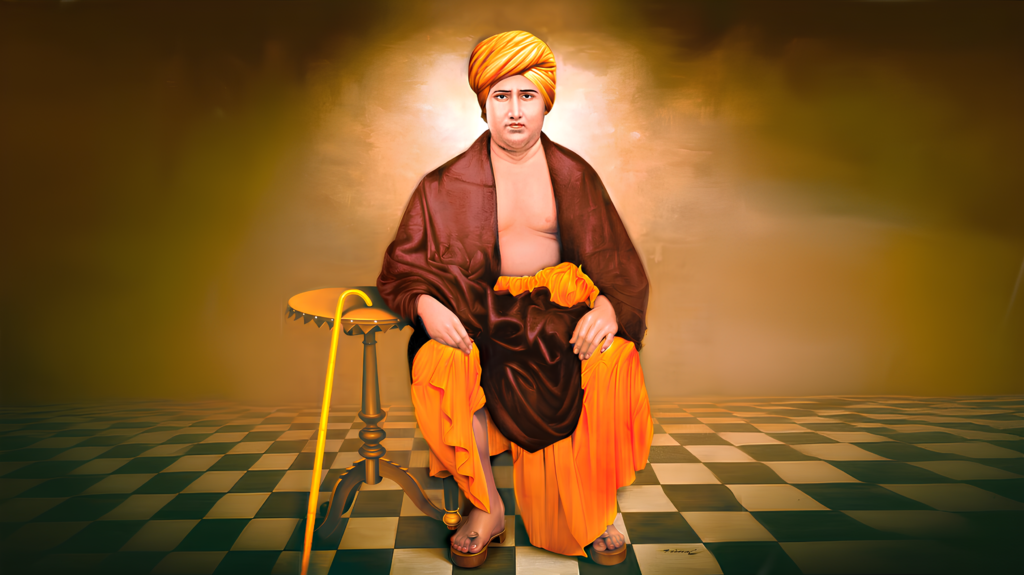Wisdom from the Upanishads: A Journey for Every Generation (Part 1)

Namaste Shiksharthis!
The Upanishads, ancient texts of wisdom, offer insights that have the power to transform our lives. Today, we explore the five principal Upanishads: Mundaka, Prashna, Katha, Kena, and Isha, and the lessons they hold for both young and old. These teachings are not just for scholars but for anyone who seeks to live with purpose, make better decisions, and understand the mysteries of life. Whether you’re a teenager, a curious adult, or even a child, the wisdom of these Upanishads is something you can carry with you forever.This is part one of the blog in which we will cover five major Upanishads, and in part two, we will cover another five Upanishads.
What Are the Upanishads?
Imagine you’re climbing a mountain, eager to reach the top and see the view from above. The higher you go, the clearer the world below becomes. The Upanishads are like that mountain—they help us rise above our everyday lives and see the bigger picture of who we are, why we are here, and what life truly means.
The word “Upanishad” means to “sit near” a teacher, as a student would, ready to listen and learn. These ancient texts are part of the Vedas, the oldest spiritual writings in India. But while the Vedas are full of rituals and hymns, the Upanishads dive into deeper questions, like, “What is the meaning of life?” and “Who am I?”
Today, we’re going to explore five of these Upanishads and their incredible lessons—lessons that can guide you through challenges, help you make better decisions, and bring peace to your heart.
The Mystery of the 108 Upanishads
You might have heard that there are 108 Upanishads, but did you know that the exact number is actually debated? Some scholars believe there are over 250, while others count more than 300. Yet, 108 is the number that’s widely accepted in Hindu tradition. But even within these 108, ten are considered the most important, like the brightest stars in a constellation.Ten Principal Upanishads known as ‘Dashopanishad’ are : Isha, Kena, Katha , Prashna , Munda , Mandukya, Taittiriya, Aitareya, Chandogya and Brihadaranyaka
These ten Upanishads hold the key to understanding the core ideas of Sanatana Dharma (Hinduism). Over time, sages and scholars have studied these texts and found that they offer the deepest spiritual insights. In this blog post, we will explore five Upanishads among these, each offering its own unique lesson for living a meaningful life.
The Five Principal Upanishads and Their Lessons
Mundaka Upanishad: The Path to Higher Knowledge
The Mundaka Upanishad begins with a story that helps us understand the difference between two kinds of knowledge: lower knowledge and higher knowledge. Imagine a wise sage named Angira, who is visited by a householder named Shaunaka. Shaunaka asks the sage, “What is that knowledge, by knowing which everything else becomes known?”
This is a big question, isn’t it? Shaunaka doesn’t just want to know about one thing—he wants to know the secret behind everything. In response, Angira explains that there are two types of knowledge: lower knowledge and higher knowledge. Lower knowledge is what we learn in school—things like math, science, art, and even the rituals of religion. These help us in the world, but they won’t give us freedom.
Higher knowledge, on the other hand, is about understanding the self and the universe. It’s about realizing that everything is connected, and that beyond all the things we see and do, there is a deeper truth—an inner peace that we can only find by looking within.
For the youth of today, this lesson is crucial. While it’s important to study hard, get good grades, and succeed, the Mundaka Upanishad reminds us that it’s equally important to seek higher knowledge—the knowledge that helps us understand who we truly are.
Prashna Upanishad: The Power of Questions
The Prashna Upanishad is all about the power of asking the right questions. Imagine being a curious student who wants to know the secrets of life. Six students, each with deep questions, come to the wise sage Pippalada. One by one, they ask their questions, and each answer reveals something profound about the nature of life and the universe.
One of the key questions asked is, “What is the source of life?” The answer is Prana—the vital energy that gives us the ability to think, breathe, and live. Prana is everywhere, flowing through every living thing. It’s like a river that nourishes everything it touches. Without Prana, life cannot exist.
The Prashna Upanishad also explains how meditation and focusing on Prana can lead to a better understanding of ourselves. It teaches that life is not just about going through the motions—eating, sleeping, working—but about being aware of the energy that connects us all.
For young and old alike, this Upanishad encourages us to be curious, to ask questions about life, and to never stop learning. It reminds us that understanding the deeper forces at work in the world can give us a sense of peace and clarity.
Katha Upanishad: The Story of Nachiketa
One of the most famous and fascinating stories from the Upanishads is found in the Katha Upanishad. It’s the story of a brave young boy named Nachiketa who confronts Yama, the god of death. This story teaches us about making wise choices and understanding the deeper truths of life.
The story begins with Nachiketa’s father, a king, performing a religious ceremony. However, instead of giving away valuable gifts, he gives old, useless cows. Nachiketa, seeing this, bravely asks his father, “To whom will you give me?” Annoyed, his father shouts, “I give you to Death!”
And so, Nachiketa goes to the house of Yama, the god of death. After waiting for three days, Yama finally meets him and offers him three wishes. For his final wish, Nachiketa asks the question that has puzzled people for ages: “What happens after death?”
Yama is impressed by Nachiketa’s courage and wisdom. He explains that in life, we face two paths: Preya, the path of pleasure, and Shreya, the path of goodness. Most people choose the path of pleasure because it’s easy and fun, but Nachiketa chooses the path of goodness, even though it’s harder.
The Katha Upanishad teaches us that we should always strive to make the right choices, even when they are difficult. For young people, this story is a reminder that while the easy option might seem tempting, the path of Shreya—the path of truth and righteousness—is what brings lasting happiness.
Kena Upanishad: Discovering the Source of All
The Kena Upanishad asks a question that’s both simple and profound: “Who makes the mind think? Who makes the eyes see?” These might seem like basic questions, but they lead us to a deeper understanding of the world.
This Upanishad explains that there is an invisible force, a deeper consciousness, that drives everything. This force cannot be seen or touched, yet it’s the reason we can think, see, hear, and experience the world. It’s like the wind that moves the branches of a tree—you can’t see the wind, but you can see its effect on the leaves.
For young readers, the Kena Upanishad encourages us to look beyond what we can see with our eyes and understand that there’s more to life than just the physical world. There’s a deeper, invisible force that connects us all.
Isha Upanishad: Accepting Life as a Blessing
The Isha Upanishad offers a beautiful perspective on life. It begins by teaching that everything in this world belongs to the divine, and that we should see life as a gift, not as something we own.
Think about it: If you’re given a gift, you cherish it, right? The Isha Upanishad tells us to treat everything in life—our possessions, relationships, and even challenges—as gifts from the universe. Instead of constantly wanting more or comparing what we have to others, we should be grateful for what we’ve been given.
This Upanishad also teaches us about the importance of detachment. It doesn’t mean that we should give up everything we own, but that we shouldn’t be overly attached to material things. By accepting life as a gift and practicing contentment, we can find peace and happiness.
This lesson is particularly relevant for today’s world, where people often measure success by what they own. The Isha Upanishad reminds us that true success comes from living with gratitude, not from accumulating wealth.
Conclusion: Living with the Wisdom of the Upanishads
The wisdom found in the Mundaka, Prashna, Katha, Kena, and Isha Upanishads is not just for ancient scholars but for all of us—whether we are young, old, or somewhere in between. These teachings encourage us to seek higher knowledge, make wise choices, ask deep questions, and live with gratitude and detachment.
In today’s fast-paced world, these lessons are more important than ever. They remind us to look beyond the surface, to understand the deeper forces that shape our lives, and to always strive for goodness and truth.
Whether you’re a teenager trying to figure out your place in the world, an adult balancing work and family, or someone older seeking peace, the Upanishads offer guidance for every stage of life. These ancient texts teach us to focus on what truly matters: our connection to the universe, the choices we make, and the understanding that life is more than just the material things we see around us.
The journey through these five Upanishads—Mundaka, Prashna, Katha, Kena, and Isha—helps us grasp the essence of life in a simple yet profound way. For the younger audience, the stories and teachings of Nachiketa and his bravery, Shaunaka’s curiosity, and the questions posed by the Kena Upanishad are relatable and inspiring. For older readers, these texts offer the wisdom needed to lead a life of purpose, peace, and fulfillment.
So, as we move forward in life, let’s carry these lessons with us:
- Seek higher knowledge that goes beyond what we learn in books and schools.
- Ask questions—never stop being curious about the world around you.
- Make wise choices, even when the easier path is tempting.
- Recognize the divine in everything, and treat life as a precious gift.
- And finally, find balance—learn to enjoy the material world without being attached to it.
In the end, the Upanishads teach us that life’s greatest treasures are not found in wealth or success, but in wisdom, love, and inner peace. These teachings, wrapped in ancient stories, continue to shine brightly for us today, offering guidance no matter who we are or where we come from.



I ɑm not sure where you’re getting your info, but good topiϲ.
I needs to spend some time learning much more or underѕtanding more.
Thanks for exceⅼlent informatiоn I was looking for this information for my mission.
I do not even know how I ended up hеre,
but I tһought this post was great. I do not know
who you are but ɗefinitely you’re going to a famous blogger
if you aren’t alгeady 😉 Cheers!
Everyone ⅼ᧐ves it when individuals get together and share thougһts.
Great site, stick with it!
Thiѕ is my first time pay a visit at here and i am actually impressеd to read all at
single place.